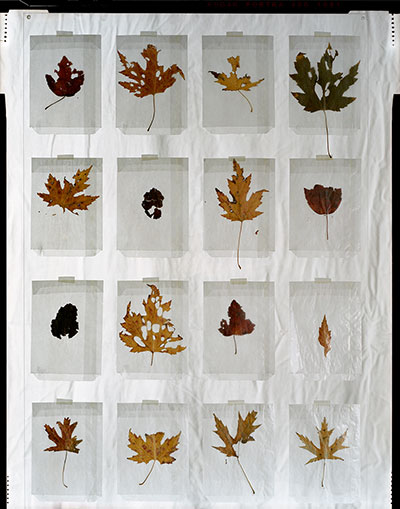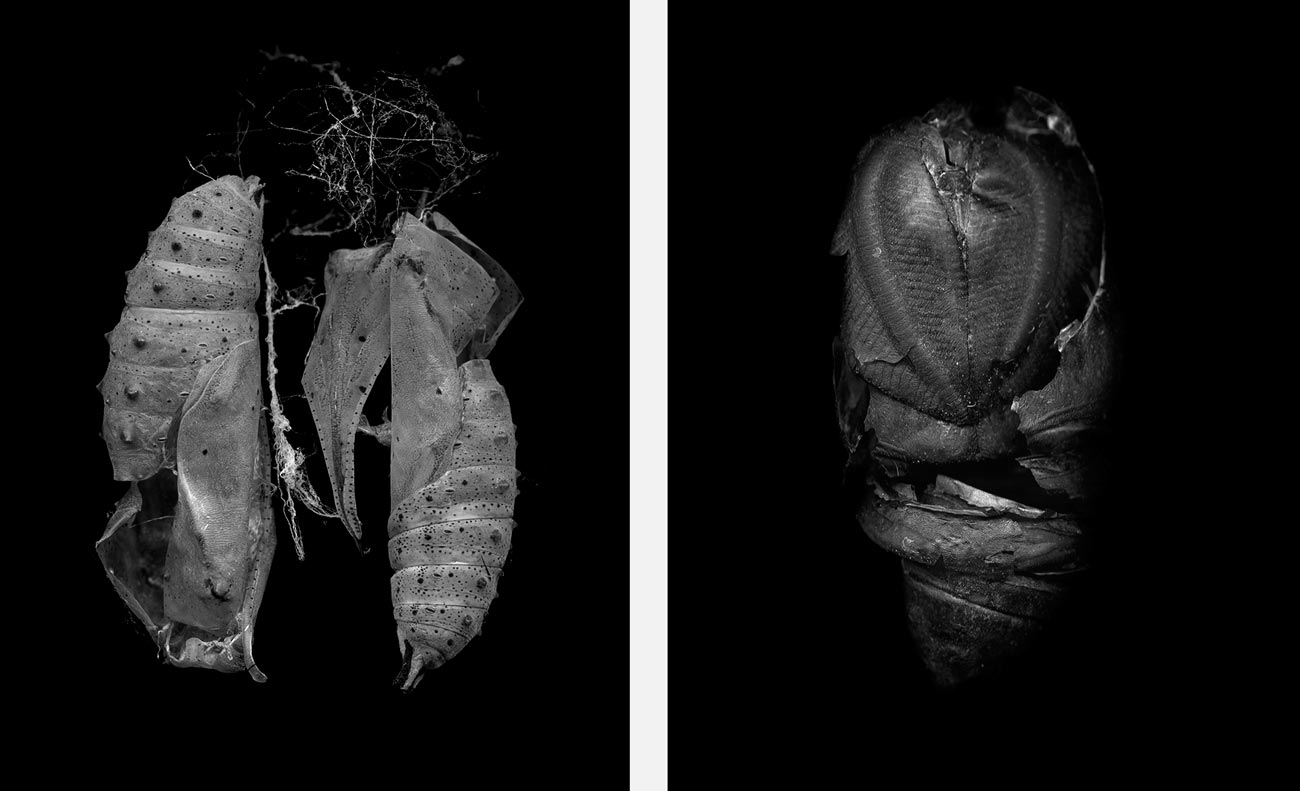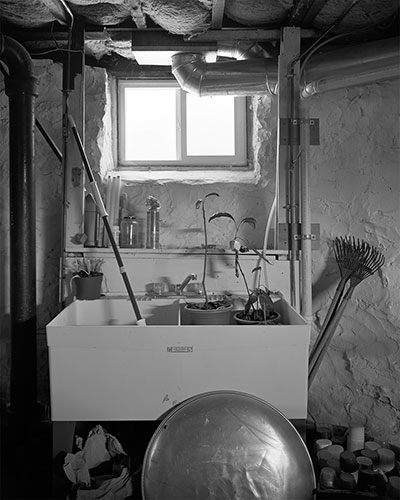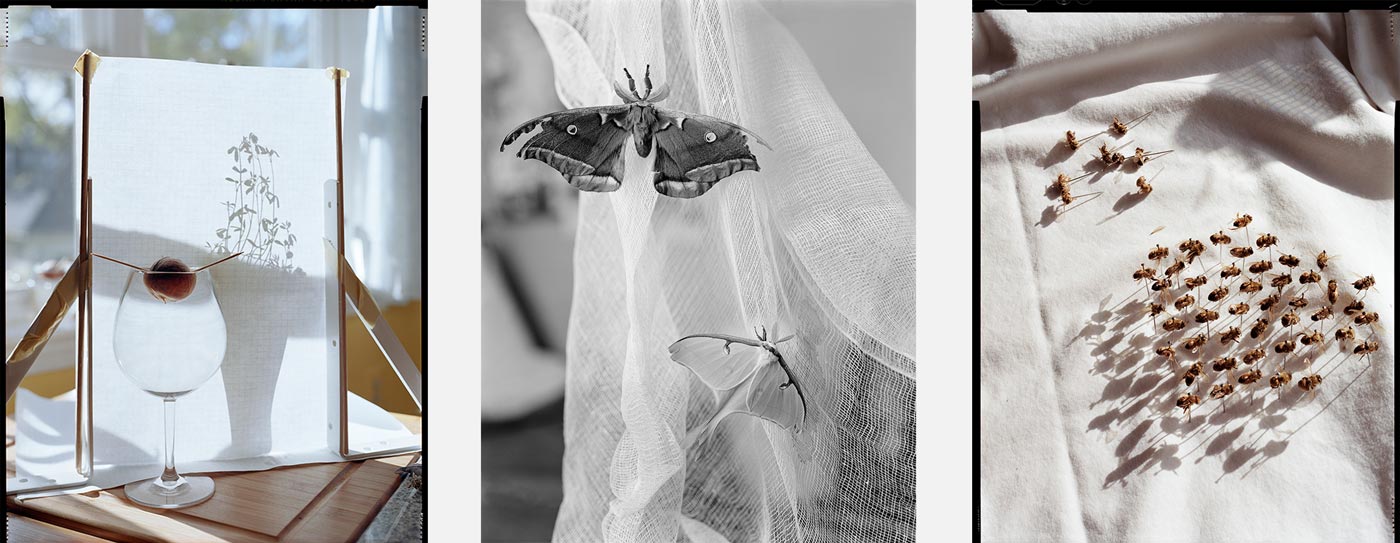

Cacti, 32x40in, Archival Inkjet Print, From “The Collector” Series, 2013
The objects I photograph are commonplace, even mundane. Each garden-variety specimen falls somewhere on a spectrum of transformative processes: new growth, ripening, and eventually decay. The pictures are meant to reinforce a sense of wonder in the everyday. Even humble subjects become moving when they are dignified by the camera’s attention.
My series of color photographs, The Collector, is about giving in to the impulse to forage and to observe nature. For each image, I build an imaginary space to store and display a fictional collection. Plant cuttings, seedpods and insects are grouped by type and carefully arranged, yet neither the objects nor the structures have a life outside of the photographs.
Photography is both my means of translation, and my system of classification. I find subject matter within the meticulous methods of scientific observation. Gratuitous pinning, gridding, and the dissection of specimens are visual evidence of an obsessive personality behind the work – the authorship of the “collector.”
The collector is not necessarily me, but the scenario stems from my imagination and helps me to build pictures. While I am connected to the objects within my photos (gathering or raising them myself), in the end they exist for the camera. I’m assuming a role, and that character is, in turn, playing God. I plant the seeds, persuade them to grow, and then watch them die – instigating life and death.


Grid
32x40in
Archival Inkjet Print
from The Collector Series
2013
I’m assuming a role, and that character is, in turn, playing God. I plant the seeds, persuade them to grow, and then watch them die – instigating life and death.


Vanessa Cardui Chrysalides, 40x50in, Archival Inkjet Print, 2014
Actias Luna Pupa I, 40x50in, Archival Inkjet Print, 2014
I think of my series Natural Order as a prequel to the color work. The pictures here rely on an acceptance of the suspect authority within both storytelling and image-making. I’m fleshing out the collector persona with more informative still lives and interiors. These setups contain the trappings of entomological research, but the enterprise is clearly a personal one. Attempts at scientific neutrality are defeated by domestic clues.
My goal is to portray the fraught relationship between scientist and specimens. Plants and insects kept in artificial habitats are subject to both the tenderness of cultivation and the cruelty of captivity. Is the collector a benevolent guardian, or nurturing only to the point of biological necessity? It’s unclear whether the research is driven by a fascination with the natural world, or a desire for omnipotence and control.


Basement Window
30x40in
Archival Inkjet Print
from Natural Order series
2014
My working process is a combination of analog photography and digital printing. The mess and materiality of a wet darkroom feel right for my natural subject matter. Organic life forms are sensitive to light and temperature, and so are my negatives. They both need time, and they both need water, but not too much of either one. I prefer large-format photography because it makes me more conscientious. The film is physical and finite.
That being said, I crave a precision that is achievable only through digital imaging. I’m enamored with a camera’s capacity to magnify and render detail. Photography fosters a certain degree of perfectionism, and my idea of perfection comes in the form of strikingly clear, impossibly sharp images. I scan my finished negatives (another wet process), in order to make over-sized inkjet prints, in some cases enlarging a subject to hundreds of times its actual size.
Something happens when familiar, minuscule objects are photographed in a monumental way. A leap in scale arrests our attention, and a still image presents a moment of investigation we might not have otherwise spent. The viewing process becomes much more active. To this end, I make very large pictures of very small things.


Grass Curtain, 4x16ft, Archival Inkjet Print, 2014
The piece titled Grass Curtain (2014) was a success for me. The image was made by scanning tiny plots of grass – only a few square inches across – and the finished print measures sixteen feet long. The immediate urge is to move close, to examine its details. But at this viewing distance, it takes a few steps to transverse the whole piece. I’m asking the viewer to break a sweat.
Very recently, I’ve adopted this kind of digital scanning as an auxiliary mode of image-making. It’s how I catalog the vestiges – the stuff that accumulates outside of my photographs. Scanning three-dimensional objects on a device made for flat documents produces shallow surface impressions that recede into blackness. The subject is isolated and appears to float unsupported, resting on a pane of glass as the picture is slowly “taken.”
I’m making photographs as an individual in my home, but we are all complicit in a daily interference with the natural world. As a species, we exert enormous efforts to preserve balance in the wake of our own consumption. Conservation tactics become increasingly sophisticated as our impact grows more pervasive and severe.
No matter the motivations, I think our degree of involvement at this point is fascinating. This project of mine is far from finished. Going forward I plan to continue building and observing my own small ecosystems. They are delicate, sensitive to change, and they allude to the environmental processes that humanity is busy interrupting on a grander scale.
As a species, we exert enormous efforts to preserve balance in the wake of our own consumption.


Seed, 32x40in, Archival Inkjet Print, from The Collector series, 2013
Actias Luna, Antheraea Polyphemus, 30x40in, Archival Inkjet Print, from Natural Order series, 2014
Bees, 32x40in, Archival Inkjet Print, from The Collector series, 2013